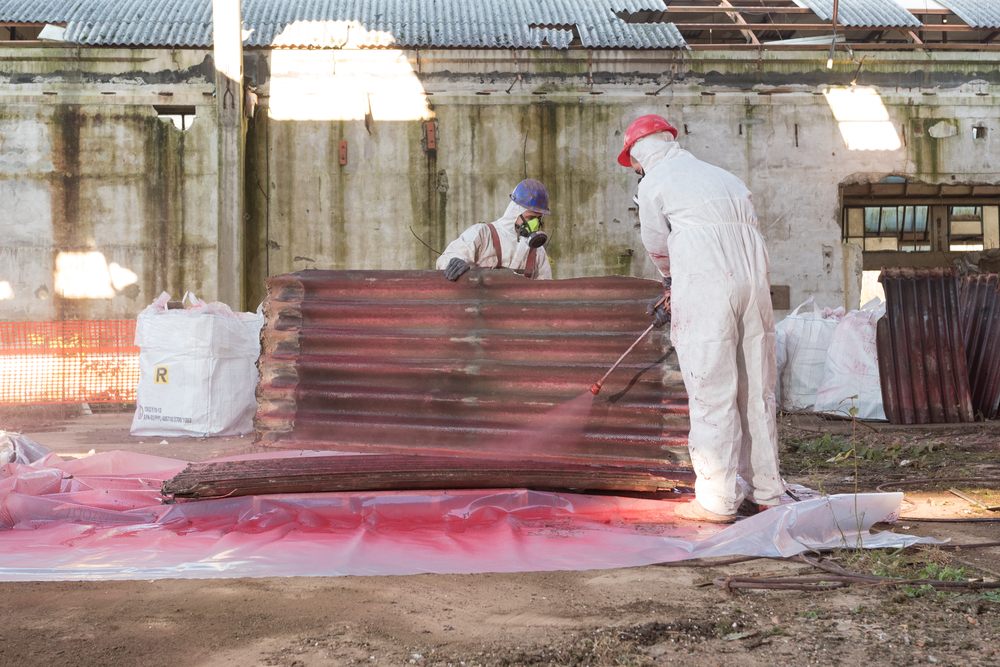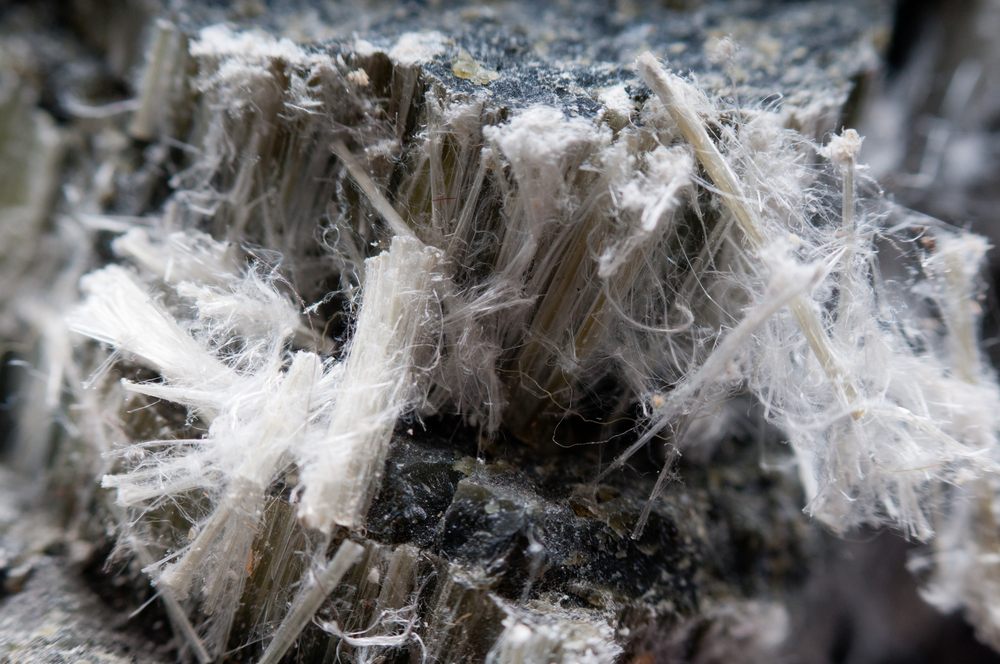The Slow Demise of Asbestos, the Carcinogen That Gave ‘The Wizard of Oz’ Snow
It took awhile.

Asbestos removal. (Photo: microlors/shutterstock.com)
A version of this post originally appeared on Tedium, a twice-weekly newsletter that hunts for the end of the long tail.
Throughout our history as a country, we’ve quickly turned on popular products we once liked because of unintended effects from that product, usually health-related. (You know, like Chipotle.)
But perhaps the product we’ve most famously done this with is asbestos, the naturally occurring fibery crystals which gained infamy after we realized that those fibers were dangerous carcinogens. It’s an issue that still gets frequently litigated today—due in part to the 27.5 million workers exposed to the substance between 1940 and 1979, according to a 1986 report by the American Thoracic Society.
The for-profit Asbestos.com notes that health issues related to asbestos were detected as far back as 1897 and the material was linked to mesothelioma as far back as the 1930s. But despite our knowledge of the the obvious health risks around asbestos, it took decades for it to be regulated and removed from general use in the 1970s.
Which is why the material, once considered a “miracle fiber,” showed up in places where it definitely wouldn’t show up today—like one of the most popular movies of all time.

The snow in The Wizard of Oz was asbestos, as was the scarecrow’s entire costume. (Photo: YouTube)
For decades, The Wizard of Oz was one of the most iconic movies on broadcast television, but somewhat lost on the public all those years is the fact that, every time you watch it, you’re watching a film that’s literally dousing its main characters in carcinogens.
That’s not hyperbole, either. During the early days of Hollywood, fake snow was commonly used in place of the real thing, and there weren’t any computerized effects that could make snow. At first, cotton was used. But then a firefighter on a film set pointed out how bad an idea it was to cover the stage with a material that tends to help fire spread.
Despite the fact that asbestos’ health risks were already known at the time, film sets started using one of the purest forms of asbestos on film stages—in part because it was fireproof and looked close enough to snow that it could fool the audience.
The effect was widely used by films of the era, but perhaps best known for Wizard of Oz’s “poppy field” scene, where Dorothy is awoken from a deep slumber after Glinda, the Good Witch of the South, introduces snow to the scene.
That white stuff covering Judy Garland? Pure asbestos, of course—in chrysotile form, making the material a bit more dangerous than, say, in building material. (By the way, not exactly a nice gesture on the part of the Good Witch there, but odds are good she didn’t know about mesothelioma, because not a lot of people did.)
In defense of Metro-Goldwyn-Mayer and other users of asbestos snow in the 1930s, this stuff was common, and not only on film sets. It was not unheard of during this period to purchase Christmas supplies that included a form of fake snow made of asbestos.
But the heavy use of the substance in The Wizard of Oz stands out, not only because the movie is so famous, but because it highlights the utility that the material played in filmmaking. The snow wasn’t the only asbestos-laden element of production: The Wicked Witch’s broom was made of asbestos, as was the Scarecrow’s entire outfit.

Close up of asbestos chrysotile fibers. (Photo: farbled/shutterstock.com)
In both of these cases, the material was used in a somewhat safer way that it was during the snow scene, but in the clothing case in particular, the risk of wearing it is high. If the costume were to tear, the fibers of the asbestos could have gone into Ray Bolger’s lungs, likely creating significant health problems down the line.
(This was not a hypothetical concern: Buddy “Jed Clampett” Ebsen, who was originally to play the Tin Man, was made severely ill by the powdered aluminum he wore on his face, with the material leaving him so ill he nearly died. Ebsen was eventually replaced; he would have to wait another quarter-century for his shot at immortality.)
These days, fake snow is a little more elaborate than the stuff used back in the ’30s. We’ve created more elaborate techniques to mimic the effect—such as the “chemical snow” used in It’s a Wonderful Life, and the marble dust used in Dr. Zhivago. Sometimes, even, movies will use actual snow.
In the wider world, the problem with quitting asbestos in one fell swoop, of course, is that it was everywhere—embedded in nearly every major building created between the 1950s and the 1970s.
Part of the blame is on industry groups, who had long been considered bad actors. The clearinghouse Asbestos.com, for example, features a lengthy timeline naming industry executives and corporations it believed had manipulated information to keep asbestos on the market.
“The industry’s survival has been due largely to its success in keeping alive the fiction that asbestos can be used safely,” historian Jock McCulloch explained in 2006. “Arguably its most potent weapons have been the suppression of evidence about the hazards of asbestos and even the corruption of science to promote doubt about the mineral’s toxicity.”
One exec quoted by the website had this particularly crass line to internally drop about the matter in 1966: “If you have enjoyed a good life while working with asbestos products, why not die from it.”
The result of this is that, if you walk into a building of a certain age, odds are very high that the floor you’re standing on contains asbestos, one result of a building industry that spent a very long time attempting to hold onto the material despite its clear health risks.
Part of the reason was a complex combination of inertia and nostalgia, like finally figuring out a good use for graphene and then finding out it was radioactive.
Take this 1952 clip from the Asbestos-Cement Products Association, which was produced years after many of the health issues were laid out. As you’ll see, the video remains steadfast in praising asbestos as a “wonder-material”:
“It was natural that the scientists would turn to asbestos, for this is a remarkable mineral,” the video says.
Decades later, of course, we’re still dealing with the fallout. You’ve surely seen the legal advertisements:
The cases were waged to such a scale to have, decades later, transformed American tort law. In a book on the topic titled Compensating Asbestos Victims: Law and the Dark Side of Industrialization, author and Bryant University professor Andrea Boggio notes the impact asbestos cases have had on the court system:
Four decades after Borel was decided, it is safe to say that asbestos litigation changed the landscape of tort and product liability litigation in the United States. It solidified the plaintiff bar and transferred to it enormous amounts of money. The accumulated wealth was used by the plaintiff bar to pursue other mass torts and to influence policy at national and local level. Furthermore, this wave of cases showed US courts’ failure to deliver efficient and individualized justice for mass torts. The bulk treatment of victims on part of law firms and the standardized life of cases after entering the court system “sacrificed attention to individualized injuries and needs.”
Or just take a look at Asbestos.com, the for-profit website that, at first blush, looks purely educational.
The reason it’s for-profit becomes clear when you discover its owner: The Peterson Firm, a law practice which specializes in class-action lawsuits.

An advertisement in a 1920 Saturday Evening Post for asbestos insulation. (Photo: University of Illinois/Public Domain)
The whole saga with The Wizard of Oz I highlighted above, in its own way, has something of a modern parallel, if an inexact one.
Currently, the Motion Picture Association of America is grappling with a lawsuit regarding the portrayal of smoking in films. The class-action suit involves a product that, like asbestos, causes cancer.
And smoking, in many ways significantly more widespread than even asbestos, has become a modern version of asbestos we’re just now in recent years trying to stop. Many of us want to blunt its cultural influence, to smother the problem, to stop the thing that’s causing people to get sick.
And that’s an understandable concern. But as asbestos exemplifies, even when we know something is dangerous, we as a society still struggle to change course.
Maybe there’s some lawyers out there who can help.
A version of this post originally appeared on Tedium, a twice-weekly newsletter that hunts for the end of the long tail.










Follow us on Twitter to get the latest on the world's hidden wonders.
Like us on Facebook to get the latest on the world's hidden wonders.
Follow us on Twitter Like us on Facebook